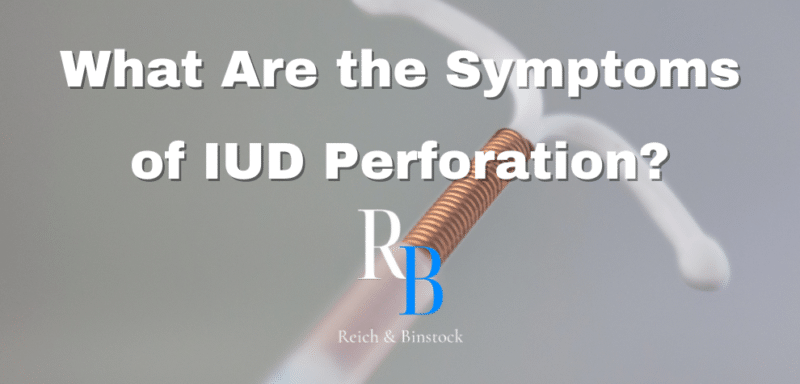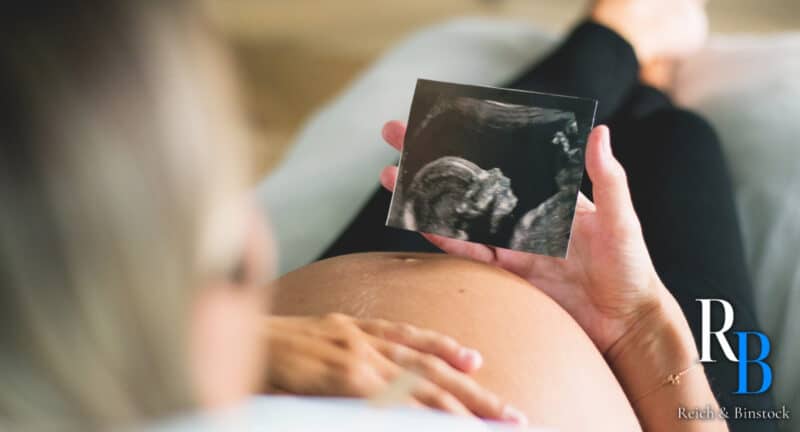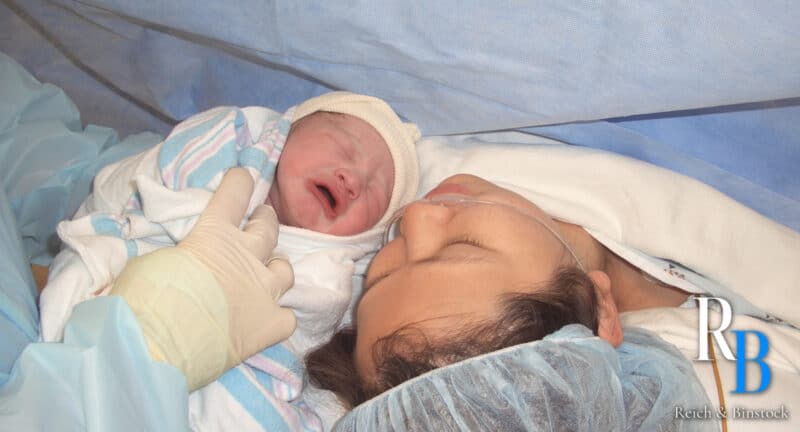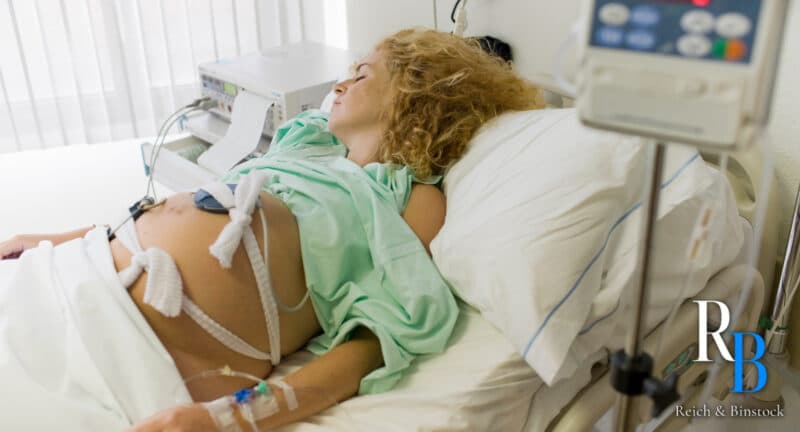UTERINE RUPTURE
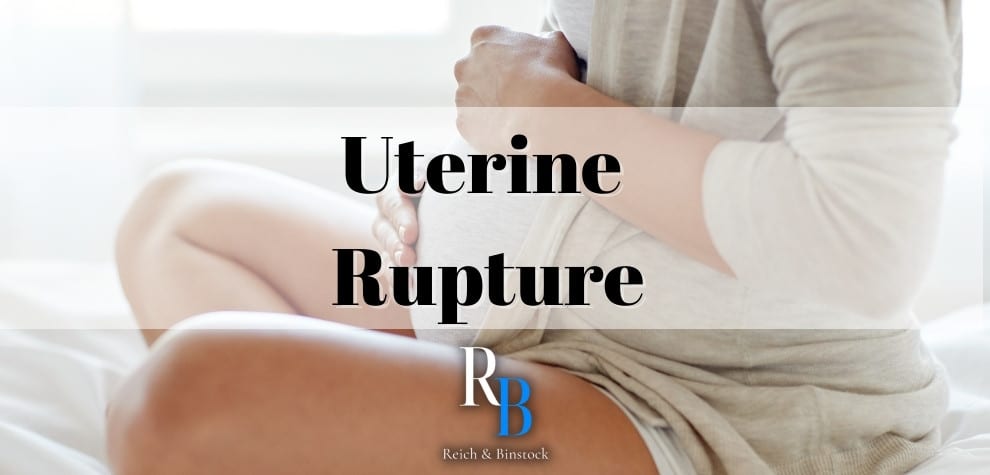
Millions of women successfully birth babies in the United States each year. However, giving birth is an enormous task that takes a toll on the mother’s body. In some cases, complications arise during labor that poses severe risks to the child and mother. One of the most dangerous complications is uterine rupture.
A rare but severe complication, a ruptured uterus, occurs during vaginal birth. Less than one percent of expectant mothers are affected. It happens most often when a woman has scars in her uterus from a prior C-section delivery or other uterus surgeries. With each cesarean section, a woman’s uterine rupture risk goes up.
After the fear and devastation you experienced from your uterine perforation, the compassionate Houston birth injury lawyers at Reich & Binstock are here to ease the burden. Let us review your case and help you move forward with a personal injury claim for the losses you suffered. Call us today at 713-622-7271 for a free consultation.
What is a Uterine Rupture?
During uterine rupture, the wall of the uterus splits open. It is an uncommon event that often threatens the lives of both mother and child. When a uterus ruptures, it compromises the layers of the uterus. Three layers include:
- The inner epithelial or endometrium
- A smooth muscle layer called the myometrium
- The serosal outer surface, known as the perimetrium
A severely ruptured uterus tears all three layers of the uterine wall. This creates an opening the infant and amniotic fluid can slip through into the abdominal cavity. A uterine rupture is a dangerous event that can cause extensive maternal bleeding and infant suffocation.
Uterine rupture can happen in a uterus with previous surgical scars or an unscarred womb.
How Common is Uterine Rupture?
Rupture of the uterus is very rare, especially for women who’ve not had a previous rupture, cesarean delivery, or other uterine surgery. It occurs with about 0.3% in women who have had a prior C-section.
When a rupture occurs, it’s often along the scar line from a C-section. A cesarean section increases uterine rupture risks, and that’s why it’s considered high risk for a woman to attempt a vaginal birth after delivery or VBAC. This complication happens most often during labor; however, it can occur earlier in pregnancy.
What Causes Uterine Rupture?
The reason ruptures tend to happen during labor is because contractions can cause the c-section scar to split open. In this case, the risks of vaginal birth after cesarean are explained to the expecting mother. She is often automatically scheduled for a c-section if she’s had two or more previous C-sections, a classical C-section, or a previous rupture. That’s because the rupture risk is high with these factors. The scheduled repeat cesarean delivery may happen early because the risk is high.
According to studies, the rupture risk is less than one percent for those with one C-section with a low transverse uterine incision.
A “classical” C-section involves a vertical incision up the uterus. Patients who have had this type of cesarean section have a much higher risk of rupture. As such, they should schedule a C-section surgery before going into labor.
Please note that your visible abdominal scar placement may be different from the incision on your uterus. Talk to your doctor to determine the location of your uterine scars.
Additional uterine rupture risk factors include:
- Labor induction drugs
- More than three previous pregnancies
- Advanced maternal age (35 years or older)
- Extended labor and delivery
- Uterine trauma (such as from a car accident or difficult forceps delivery)
“Cervical Ripening” Drugs
The overuse of cervical ripening drugs, such as Cervidil and Pitocin, also plays a role in the occurrence of uterine tears. Pitocin’s FDA package insert reads that maternal death “hypertensive episodes, subarachnoid hemorrhage, rupture of the uterus, and fetal deaths and permanent CNS or brain damage of the infant due to various causes have been reported to be associated with the use of parenteral oxytocic drugs for induction of labor or for augmentation in the first and second stages of labor.”
Types of Uterine Rupture
Uterine rupture involves a tear in the full-thickness upper section of the uterine muscle and the overlying serosa (a layer of tissue on the exterior of the uterus). Typically it occurs during labor and can affect the broad ligament or bladder.
There are two types of uterine rupture:
- Incomplete – The peritoneum remains undamaged, and the contents of the uterus stay inside the uterus.
- Complete – The peritoneum tears and the contents of the uterus spill into the peritoneal cavity.
This complication is uncommon. However, if it occurs, fetal and maternal morbidity is high.
What Is Uterine Dehiscence?
While uterine rupture is a medically observable and complete tearing of a uterine scar before or during labor, uterine dehiscence is an incomplete scar separation where the serosa remains intact.
Uterine dehiscence is often discovered during a C-section, noticed on an obstetric patient’s ultrasound, or diagnosed while a patient is not pregnant.
What Is An Abdominal Pregnancy?
An abdominal pregnancy can result from a uterine rupture. Abdominal pregnancy is an ectopic pregnancy.
It happens when a fertilized egg implants outside of the uterus, such as on tissues or an organ in a woman’s abdominal cavity.
Abdominal pregnancy is treacherous for the mother and the unborn child. If the placenta detaches from abdominal tissue or an organ, the mother is at risk for internal bleeding. The dangers for the baby include no amniotic sac protection and not getting enough nutrients and blood for healthy fetal development.
Fetuses that are born from an abdominal pregnancy are often malformed.
Signs of An Abdominal Pregnancy
A woman experiencing abdominal pregnancy may be unaware of her condition. At first, the pregnancy symptoms may mimic those of a normal pregnancy, including:
- Nausea and morning sickness
- Tender breasts
- Missed menstrual cycle
- Fatigue
However, an abdominal pregnancy may also include vaginal bleeding and abdominal pain. If these symptoms occur, an expectant mother should get checked by their physician.
Abdominal Pregnancy Diagnosis
Often abdominal pregnancies don’t get diagnosed until later or are missed altogether. If a patient has pain in her abdomen or when the baby moves, or if the fetus isn’t in the correct location in the mother’s body, a doctor may believe it is an abdominal pregnancy.
Blood tests measuring human chorionic gonadotropin (hCG) levels may also indicate a problem. As the pregnancy continues, hCG levels should rise.
An ultrasound diagnoses the condition and pinpoints the gestational sac’s position. Laparoscopy confirms the diagnosis. This involves using a small viewing instrument to see inside the uterus.
It’s unusual to have a successful abdominal pregnancy. Most of these pregnancies require medical or surgical termination.
Uterine Rupture Risk Factors
The most common uterine rupture risk factor is a previous cesarean delivery scar. Other forms of uterine surgery using full-thickness incisions that leave uterine scars, such as myomectomy, oxytocin prostaglandins to speed labor, high parity, and dysfunctional labor, can also precede uterine rupture.
Additional causes of uterine rupture include:
- Overstretched uterus from carrying multiple babies
- Fetal version performed internally or externally
- Previous uterine perforation from organ removal
- Excessive amniotic fluid or polyhydramnios
- Iatrogenic perforation (a complication from endoscopy)
- Physician failure to recognize slowed later due to excessive uterine contractions against a lower uterine restriction ring or Bandl’s ring
The medical community widely accepts that previous cesarean scars and labor-inducing drugs are the most significant uterine rupture risk factors.
Signs of Uterine Rupture
If a fetus’s heart rate slows down or the mother experiences sudden, severe abdominal pain with an epidural block, a doctor should consider uterine rupture.
The tear’s size and location determine physical symptoms and signs of a rupture. Ruptures occurring at the site of a prior cesarean delivery scar typically exhibit milder symptoms and less intensity than a spontaneous uterine rupture of an unscarred uterus.
When uterine ruptures occur during labor, contractions may slow and decrease in intensity. The abdominal pain may not be severe. Instead, it may occur during a contraction’s peak, and the mother may describe it as a feeling of something “ripping” or “giving way.”
Additional signs include:
- Chest pain
- Pain between shoulder blades
- Pain when breathing
- Excessive bleeding
- Baby’s head retreats into the birth canal
- Hypovolemic shock (signified by a drop in blood pressure, rapid heart rate or breathing, anxiety, and pale, clammy, and cool skin)
Dropping blood pressure is typically a sign of bleeding. Additionally, signs the fetus isn’t getting enough oxygen include decreasing heart rate after contractions, reduced variability, fast heart rate, and fetal bradycardia.
Fetal monitors are valuable tools for tracking fetal distress during labor and delivery. It may indicate when a uterine rupture occurs.
Uterine Rupture Treatment
Surgeons must remove the baby quickly after discovering a uterine rupture. The baby suffers severe injury due to lack of oxygen if not delivered swiftly via emergency cesarean delivery.
It typically takes between 10 and 37 minutes for surgery to occur after a rupture is confirmed. The less time surgery takes, the better the maternal and fetal consequences.
Our Houston medical malpractice attorneys typically litigate birth injury cases based on how quickly the rupture diagnosis occurred and how fast the baby was delivered.
The rip in the mother’s uterine wall undergoes surgical repair after the delivery. However, 5-13% of women require a hysterectomy because of excessive bleeding. This happens more often when the uterine tear is vertical. Others recover and bear more children in the future.
Stopping the use of labor-inducing drugs is often the solution for a developing rupture. Heavy-handed Pitocin use is a documented precursor of uterine rupture.
Uterine Rupture Birth Injuries
Among the most catastrophic childbirth complications, uterine rupture immediately puts the baby in danger of acute oxygen deprivation. An adverse outcome is likely to result if the placenta or fetus slips through a uterine wall tear.
An emergency c-section performed within 10 to 30 minutes of a rupture diagnosis may not be quick enough to prevent hypoxia and infant brain injuries. Asphyxiation death is also possible.
About six percent of infants do not survive this rare but catastrophic complication. Children who survive are at risk for significant brain injuries like cerebral palsy and hypoxic-ischemic encephalopathy (HIE). HIE can cause brain deterioration, seizures, cardiorespiratory problems, and death. A child’s muscle development, coordination, and basic motor skills are significantly impacted by cerebral palsy.
Uterine rupture birth injuries came with a staggering financial cost. The baby will likely require a stay in a neonatal intensive care unit due to oxygen deprivation, and their health conditions may also require expensive lifelong care.
Can You Have a Baby After Uterine Rupture?
Because uterine rupture is a major obstetric complication, many women cannot have additional children. This is because internal bleeding caused by uterine rupture frequently requires an emergency hysterectomy.
However, women who undergo a successful repair of the uterine tear may have more children.
Other Considerations
Women who have uterine rupture and repair are often advised to undergo a C-section for future pregnancies to avoid a subsequent uterine rupture. However, your physician may agree to trial labor and delivery if your risk is low.
If you choose a VBAC, the doctor may evaluate these factors:
- Uterus size
- Delivery of previous children
- Size of baby
- Vital signs
- Recovery time following previous childbirth
The type of incision made during a prior cesarean section is also considered:
This incision is made horizontally across the thinnest part of the uterus and lower abdomen. The most common type of incision, it also has the least risk of future uterine rupture.
This vertical incision goes across the lower abdomen. The risk of future rupture is higher with this incision type.
This is the “classical” C-section incision. It is typically made vertically into the upper part of the uterus above the belly button. Often utilized in the delivery of early preterm infants, it has the highest risk of future uterine rupture.
During spontaneous labor, your physician monitors you closely to ensure the baby is delivered safely. You could end up with a C-section if the rupture risk increases.
However, if you do not go into labor spontaneously, your doctor may be unwilling to induce you with drugs that speed up the labor process. This is because these medications increase uterine rupture risks.
Do I Have a Valid Uterine Rupture Lawsuit?
Your Houston uterine rupture attorney will review your medical records. These records could indicate negligence by your physician. A childbirth injury or the death of the mother or child could have resulted from medical negligence. Damages may be awarded if this is the case.
If the mother or child lost their life because of a ruptured uterus, their family members could file a wrongful death claim for their loss.
Multiple parties could be at fault, including an emergency room physician, the medical team, the mother’s obstetrician, the medical facility, manufacturers of a defective medical device, or even a driver that caused a collision.
The attorneys at Reich & Binstock look into your case and determine the best way to move forward.
Read Also: Can I Sue My Doctor For Misdiagnosis?
How Much Can I Get for My Birth Injury Case?
Personal injury and wrongful death lawsuits are all unique. And your compensation claim is based on various factors. It isn’t easy to quickly determine an amount.
If your child suffers from debilitating birth injuries, you may be entitled to compensation for pain and suffering and medical costs to treat your child for the duration of their life.
Hire a Houston Uterine Rupture Lawyer Today
A uterine rupture impacts a mother and child for a lifetime. It can cause long-lasting health complications and high costs for care.
If risk factors were present and not sufficiently addressed by medical providers and a uterine rupture occurred during childbirth, parents should look into taking legal steps.
The Houston law firm of Reich & Binstock represents clients who’ve suffered various types of damage. From medical malpractice and pharmaceutical injuries to product liability and car accidents, our firm is ready to assist those who need our help.
We invite you to contact our legal team to get started on your case. Our phone number is (713) 622-7271. Our experienced and dedicated attorneys have helped clients achieve a beneficial outcome for their uterine rupture injuries.
There is never a fee unless we recover on your behalf.
Additionally, clients are not obligated to pay expenses if a recovery is not made.
















